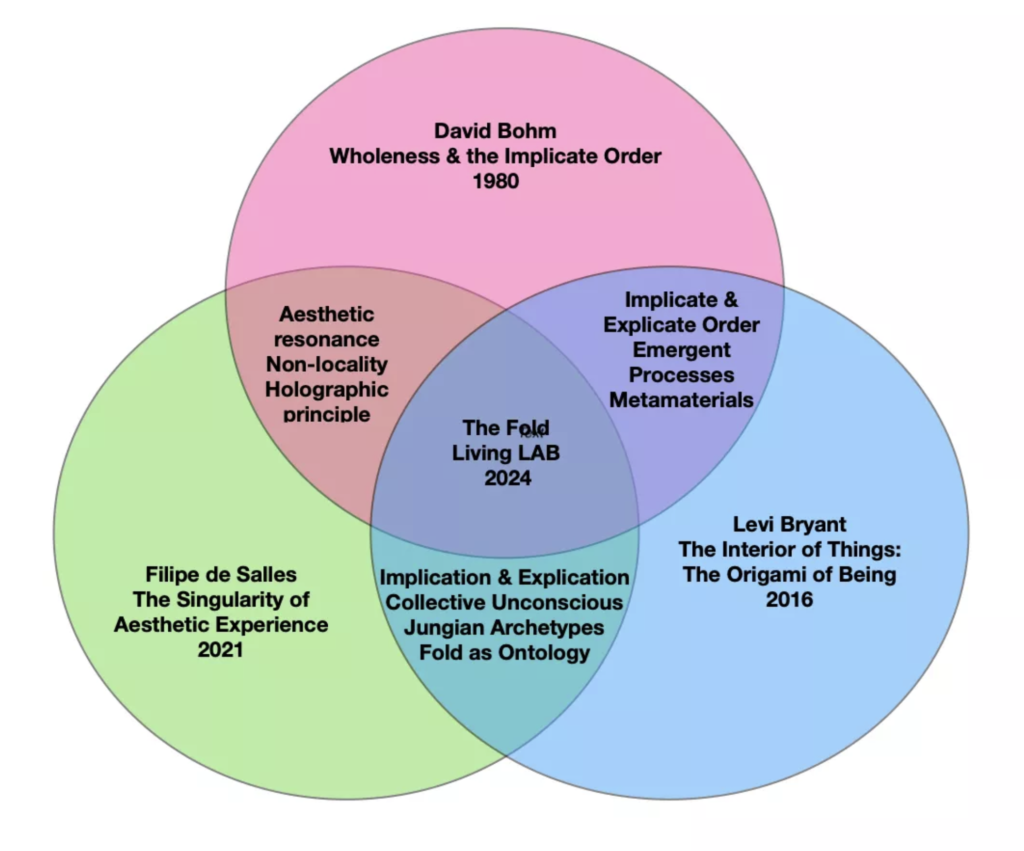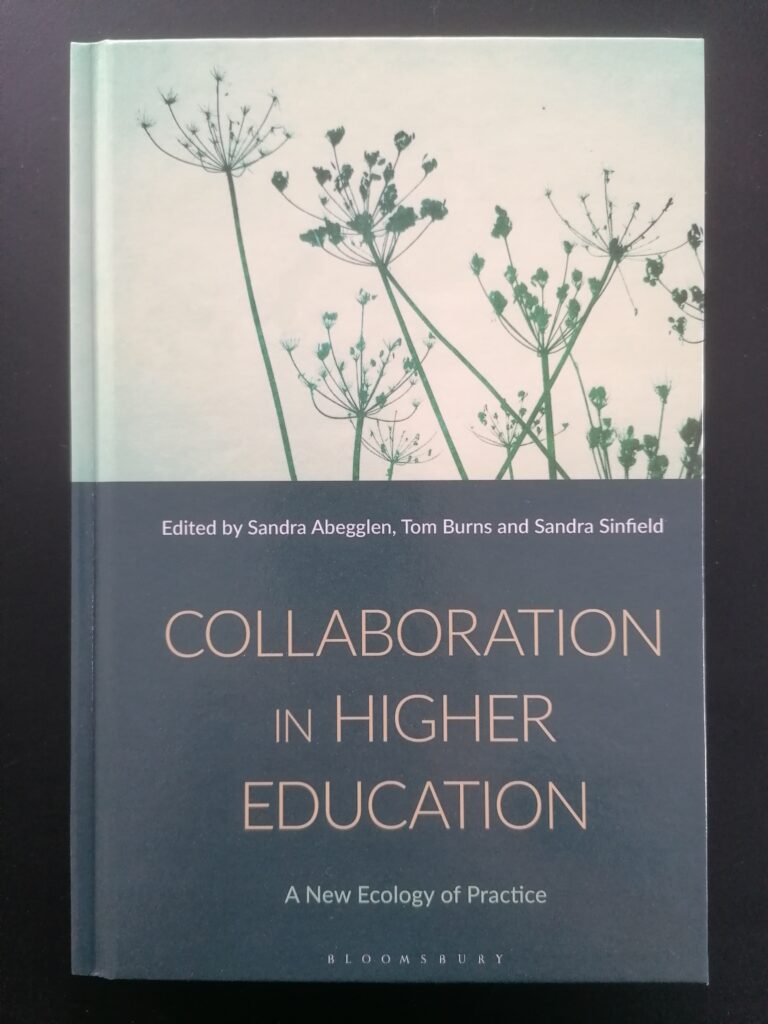The following is a selection of artistic research and writing through recent MFA studies at the National College of Art and Design, Dublin, (NCAD) 2022, and a series of recent collaborations with the Robotics, Design Thinking, Theatre Studies, and Music Departments at University College Cork, (UCC), Ireland. We have shared and published some of this research and in October 2023 I was an invited speaker to present at the International Symposium for Structures and Materials Inspired by Origami, (SAMIO), Shaoxing, China, 2023. We also received SATLE funding to create The Fold as a Living Lab (LL) for Innovative, Material-led, Transdisciplinary Teaching and Learning, UCC, which was the basis of this presentation and which we also showcased in Cork with guest speaker Matthew Gardiner, (Ars Electronica), through the subject of Oribotics. In December 2023 we received the UCC President’s Award for Excellence in Teaching and the second phase of the LL was scheduled for early 2024 when we welcomed esteemed guest speaker Professor Filipe de Salles, University of Campinas – UNICAMP, São Paulo, Brazil. Prof. de Salles to share his radical theory of aesthetics based on the Jungian theory of the archetype, and the holo-informational models of Karl Pribram and David Bohm. Having been awarded a research residency at Centre Culturel Irlandais, (CCI), Paris in July 2023 through Cork County Council Arts Office, I was able to combine this line of artistic research with the folded ontology of Levi Bryant and the implicate order of physicist David Bohm. This line of inquiry forms a large part of the LL ethos and reflects a decentralized, contemporary shift in Higher Education that Peter M. Rojcewicz calls ‘the noetic turn’. (See Venn diagram below).

The Radical Aesthetics of Filipe de Salles and the Four Aristotlean Causes:
In a climate where there remains much debate around the aesthetic process, Prof. Filipe de Salles proposes a radical new theory of aesthetics as a form of resonance with Jungian archetypes. This essay aims to clarify this process by first giving a brief comparison of different historical meanings of the word aesthetics, and then giving clarity to this process by comparing it to Aristotle’s four causes; efficient, material, formal, and final.
Paper as Teacher: Challenging Dominant Learning Norms in Higher Education through Collaborating in Origami. (Book chapter: Supple, O’Neil, Pentek, Hao).

In August 2023, we were very excited to see our first book chapter published that researches origami as an educational tool. This is based on many years of collaborating, exploring, and publishing together. This most recently was with SATLE funding, UCC to explore the Fold as a Living Lab for Innovative, Materials-led, Transdisciplinary Teaching and Learning. The book is titled Collaboration in Higher Education: A New Ecology of Practice by Sandra Abegglen, Tom Burns, and Sandra Sinfield, and an open-access free version can be downloaded by following the title link, courtesy of Bloomsbury Publishers. Our chapter can be seen below: http://alexpentek.com/wp-content/uploads/2023/08/FINAL_6SEPT_Case-study_Supple_Oneill_Pentek_Hao.docx-2.pdf
Folding with Endless Potential: Invited presentation at the International Symposium for Structures and Materials Inspired by Origami, Shaoxing, China 2023.
Spanning across academic and artistic research methodologies through materials has become an important part of my practice. Prof. Guangbo Hao, (Robotics, UCC), invited me to be the lead co-author on a paper we were invited to present at SAMIO 2023 (International Symposium on Structures and Materials Inspired by Origami 2023, held in Shaoxing, Zhejiang, China. We have collaborated on numerous successful projects over the years, most recently with Dr. Briony Supple and Nico Lorenzutti, (UCC), with a living lab exploring the fold as a transdisciplinary, materials-led innovative method of research across multiple fields, which we shared at the conference. Having time to reflect on and write these ideas while on residency at the Centre Culturel Irlandais, Paris, (co-funded by Cork County Council Arts Office), was crucial. This paper has been accepted by the All Ireland Journal of Higher Education (AISHE-J) and was inspired by our collective experience as well as my artistic research into the fold as an ontology, the ideas of philosopher Levi Bryant, physicist David Bohm, and the radical aesthetics of Prof. Dr. Filipe de Salles.
Abstract. Folding with Endless Potential: Origami as a Doorway to Innovation. Pentek et al. 2024.
Observationism:
During my materials-led MFA research at NCAD in 2022, I began to explore a method of artistic research that can be called ‘Observationism.’ Having since had time to reflect on what this new term means, the following short essay explains observationism and why I believe it could be helpful to anyone conducting research both inside and outside the arts. Observationism: Seeing beyond the surface of things. Alex-Pentek. 2023.
Un-Folding Dreams: A brief review of the 59th Venice Biennale commissioned by the Irish Architecture Foundation. Alex Pentek.
https://architecturefoundation.ie/news/59th-venice-biennale/
MFA Research: (1st draft)
The Fold as a Site of Transformation. Alex Pentek 2022
Un-Folding Realities.
This short performance lecture explains the fold as an ontology or a site of transformation between ‘being’ and the ‘field’ from which it both arises and enfolds within itself. Drawing on ‘The Origami of Being’ and the writing of Levi Bryant, and also material-led artistic research in Design Thinking and Robotics, I introduce these ideas through a visual vocabulary of folds to allow us to look both on and beyond the surface of things. A more in-depth description can be seen here: Alex Pentek. Un-folding Realities. 2022
Big thanks to Claire Murphy for her filming and editing, Chris Hurley of Cork Film Services for lighting equipment, the National Sculpture Factory, where the work was filmed, and Belinda Quirk and her marvelous team at Solstice Arts Centre.
Beckett’s Bookshelf:
This short essay examines Samuel Beckett as an early postmodern artist and his Absurdist use of language through the philosophy of Ludwig Wittgenstein and was inspired by a captivating series of lectures by acclaimed Beckett Scholar Judith Wilkinson at NCAD.
http://alexpentek.com/wp-content/uploads/2021/07/Becketts-Bookshelf-1-1.pdf
Origami & Robotics:
Thanks to Dr. Orla O’Flynn, (President of Galway Mayo Institute of Technology), and Trish Brennan, (Head of Fine Art, CIT Crawford College of Art and Design, Cork), for introducing me to Dr. Guangbo Hao several years ago. Guangbo is a Senior Lecturer in Electrical and Mechanical Engineering at University College Cork, and we have been researching ways to explore connections between the ‘rigid origami’ that I use in my gallery work and robotics. Last year, just before lockdown we delivered a series of lectures and workshops using origami as an educational tool for robotics education. This explores a fluid trans-disciplinary approach between material learning, hands-on experience, and kinematic mapping of these folded joints using mathematical axioms contained within the folded surfaces of origami.
Our paper, titled ‘Art into Engineering: Demonstrating how Origami Creativity can Inform Robotics Education,’ was presented by us both at the Engineering Education for Sustainable Development annual conference online in June 2021, and can be seen on the link below. Since our first collaboration, Guangbo and I have co-authored a total of four research and conference papers linking origami with robotics and we look forward to continuing this area of exciting research together.
Some Thoughts on Martin Puryear:
I was lucky enough to see Martin Puryear represent America at the US pavilion at the 58th Venice Biennale in 2019, which was incredible and had a lasting effect on me. Part of our MFA study was to write a critique of a monographic essay on an artist of our choosing, so Puryear seemed like the natural choice…
Themes of Displacement.
According to the International Organisation for Migration Report in 2020, there are 172 million people affected by migration. This shows that displacement is a global phenomenon affecting all aspects of social, cultural, and political life. This short essay briefly examines how such a heavily politicized theme helps to identify key questions surrounding identity, agency, ethics, truth, and aesthetics by drawing on the theoretical writing of Baudelaire, Greenberg, and Danto. Looking at specific works by Ai Wei Wei, Edmund De Wall, and Richard Mosse, I examine ways that this theme continues to influence post-modern theory through the writing of Giorgio Agamben, Nicolas Bourriaud, and Arthur Danto.
http://alexpentek.com/wp-content/uploads/2021/07/Art-and-Displacement-Alex-Pentek-2021.pdf
Object-Oriented Ontology:
I recently discovered Graham Harman’s idea of object-oriented ontology (OOO), as a new way to situate modernism, post-modernism, and 20th-century philosophy with the inner qualities of things. Loosely defining events and things as ‘objects’ with only two categories of real and sensual objects each with real and sensual qualities, I explore this approach for future artistic research to possibly examine some of Wittgenstein’s ideas, such as that some things cannot be said or “uttered”, but must instead be shown.
http://alexpentek.com/wp-content/uploads/2021/09/Utterring-the-the-Unutterable.pdf
The Origami of Being:
After reading Harman’s Object Oriented Ontology I recently discovered Levi R. Byrant’s response to the autonomy and separateness of Harman’s objects in ‘OOO’, with his remarkable paper ‘The Interior of Things: The Origami of Being.’ (Available on The Central and Eastern European Online Library). Loosely speaking, this explores the idea of an ontology that is folded between an object and the field from which it arises and/or is experienced. To begin to explore these ideas I created the following short video: Here, a randomly crumpled piece of paper is opened out and after the unplanned pattern of mountain and valley folds are marked out, I test these folds against the four origami axioms put forward by Robert Lang. Ending with a couple of brief quotes from Byrant’s paper mentioned above, this is a new direction for my artistic research that I am very excited about!
https://vimeo.com/642621111 Password: origami
Sub-Urban Myths:
This essay builds on earlier research around infrastructures to examine some historical background to the mythically oppositional relationship between urban and rural places of cultural production. From the pastoral romanticism of Wordsworth’s poetry to the giant conurbation of the BAMA sprawl in Gibson’s futuristic novel Neuromancer, and the ‘necropolitics’ of Michael Truschello, I ask if there are criteria to better understand if urban and rural spaces are mutually exclusive or possibly interdependent? Thanks for the Truschello recommendation by fellow artist Peter Power, which was very helpful.
http://alexpentek.com/wp-content/uploads/2021/09/Rural-and-Urban-Myths.pdf
